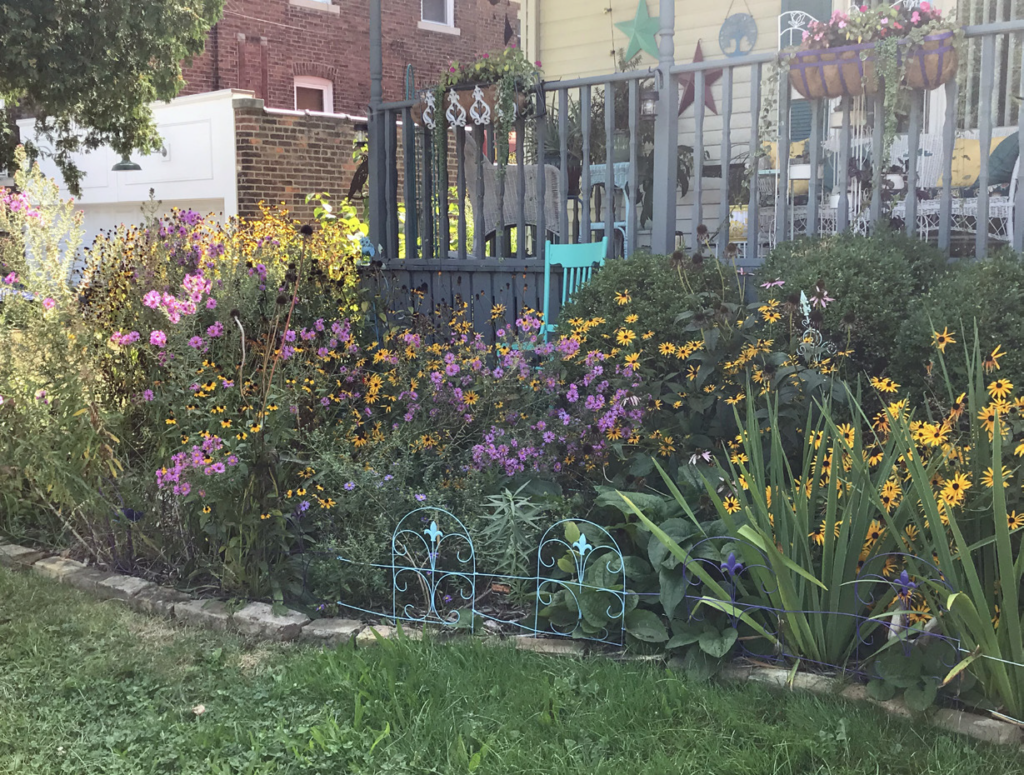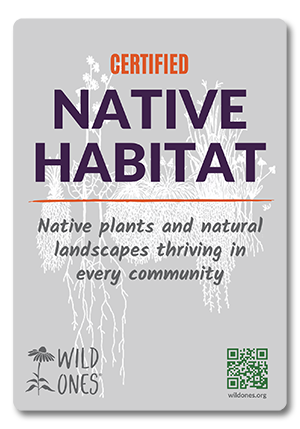In the middle of an urban-dominant environment, the home of Wendy Gochenaur provides a small, yet impactful oasis for wildlife to congregate and thrive. With over 95 native plant species, Wendy’s yard provides sanctuary for pollinators, birds and snakes.
This is an excerpt from the Wild Ones Journal
Current members can log in to read the latest issue or check out the Journal Archives.
After moving to her home in Bloomington, Illinois in the fall of 2017, Gochenaur discovered her passion for native landscaping and gardening after attending a local plant sale through the Wild Ones Illinois Prairie Chapter. Wendy had always wanted to pursue native landscaping, but never had the opportunity since she was living in an apartment up until the purchase of her new home. It was at the plant sale she discovered she could receive free education and a discount on future plant sales with a membership through the chapter, so she jumped at the opportunity to pursue her dream of native gardening.
“Being a member of Wild Ones has helped me understand more about native plants and which plants are native to this area,” Gochenaur said. “Wild Ones tipped off my journey, and I hit the ground running as far as native plants go.”

Her passion for native landscaping and gardening came from her motivation to create a wildlife habitat. “The sterile, chemical controlled insectless lawns were never appealing to me and a lot of nonnative plants have no benefit for wildlife.”
Although she does not have prior gardening experience, Gochenaur said that “gardening runs in the family–it’s in my blood,” and explains that her father and grandparents frequently spent their time gardening. She describes herself as a “nature-loving hippie” and now loves gardening, finding the activity to be a major stress reliever.
“I feel like I am helping the environment,” Wendy said. “It’s such a rewarding experience. Everything about it is positive; there’s nothing negative about gardening, and I feel so accomplished.”
Working on a relatively small lot with 1,500 square feet for the garden, Gochenaur and her spouse have been able to “plant a pretty extensive garden with a wide variety of natives,” including bleeding heart (Dicentra spectabilis), Virginia waterleaf (Hydrophyllum virginianum), wild ginger (Asarum canadense) and wild geranium (Geranium maculatum).
When it comes to planning her garden, Wendy’s motto is to “wing it,” and she has learned her gardening techniques along the way. “I just kind of follow my own process. My partner and I do all our own gardening. I take it section by section. I like curved whimsical shapes, and I use old bricks for my garden borders so I lay them out in the shape I want and then from there I dig up all the grass. Then, I shake out as much dirt as I can and compost the grass.”
Gochenaur’s garden is mostly self-sustaining, as native plants are adapted to the local environmental conditions. She starts preparing her garden for summer after the last frost in spring so that the insects can come out of hiding.
“It is fairly low maintenance. I don’t have to fertilize, and I don’t really have to water because everything is used to this climate.” She will remove any weeds, such as dandelions, and nonnative grass that creeps into her garden.
“I love the spring ephemerals like bloodroot, trillium and Jack-in-the pulpit, but the beauty of prairie flowers like black-eyed Susan (Rudbeckia spp.), compass plant and echinacea just make for a show-stopping scene in midsummer.”
Her garden also contains edible plants, such as chokeberry (Aronia sp.) and wild nodding onion (Allium cernuum). She enjoys using wild bergamot (Monarda fistulosa), crimson beebalm (Monarda didyma) and the branches and leaves of spicebush (Lindera benzoin) in teas.
Not only do native plants cover both the front and back yards, but the side yard as well, which Wendy calls her “sun yard” because of the high amount of sunlight this area receives during the spring and summer. Plants such as prairie smoke (Geum triflorum), tall coreopsis (Coreopsis tripteris), obedient plant (Physostegia virginiana) and common milkweed (Asclepias syriaca) are specifically placed in this area because they thrive in significant sunlight.

In fact, Gochenaur is planning to expand her sun yard by at least another foot because the “plants are so happy that they are getting so big that they are flopping over. This coming year, it’s going to be all about the sun yard.”
Gochenaur’s native plants are not the only sustainable feature in her yard. In addition to composting vegetable matter and shredded paper, she also has an owl and bat house.
Admittedly, she has yet to see these animals occupy the houses, but is hopeful that one day she will. She has installed bird feeders, bee baths and black slate rocks for snakes to sunbathe “to encourage the wildlife to see our yard as a little oasis.”
A variety of wildlife visit her yard, including hummingbirds, hummingbird hawk moths, tiger swallowtails, monarch butterflies, great black wasps, mason bees, honey bees, sweat bees, garter snakes and goldfinches.
Wendy also plants an abundance of milkweed to encourage monarch butterflies to come to the yard. “They love our yard. I can go outside and find five caterpillars a day!”
When asked about her favorite part of her garden, Wendy said: “My cactus garden is one of my favorite features. It literally stops people on the sidewalk. A lot of people don’t know there are cacti native to Illinois.”

Not only has Gochenaur’s hard work provided habitat for local wildlife, her garden has also received recognition for its beauty. After being nominated by friends, Wendy and her spouse received the Bloomington Beautification Award from the city’s Citizens’ Beautification Committee in November of 2022 for making a positive contribution or improvement to Bloomington’s appearance through dedication and efforts towards the landscaping, architecture, and maintenance of their property.
“A lot of plants and animals are becoming more endangered,” Wendy said. “It’s nice to know that I have food for migrating birds and a habitat for caterpillars. I adore the insects and different birds we get. It makes me feel like I am giving back to the native landscape that used to be there.”

This member garden is a Certified Native Habitat!
This program celebrates members creating spaces for wildlife and pollinators. Your garden can be part of the movement!
Written by Mackenzie Seymour. Mackenzie graduated from the University of Wisconsin Oshkosh with a bachelor’s degree in biomedical science and a minor in neuroscience. She is currently the experiential learning and marketing coordinator at Burpee Museum of Natural History in Rockford, Illinois.

